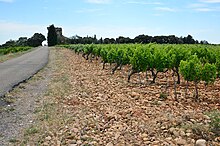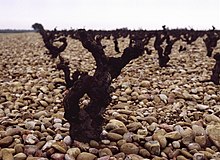Châteauneuf-du-Pape (wine region)
Châteauneuf-du-Pape is a wine-growing region in the southern Rhône Valley named after the town of the same name . The designation of origin Châteauneuf-du-Pape has the status of an independent appellation . In good years it can be one of the great red wines of France. It is also white produces Châteauneuf-du-Pape.
properties
Thirteen different grape varieties can be used for the production of red Châteauneuf-du-Pape, which are harvested and vinified separately and finally composed into a cuvée . If you count the different subspecies of the individual grape varieties, you come to 22 grape varieties. For example, Grenache is approved in the varieties Noir, Rosé, Gris and Blanc.
The Grenache grape variety can achieve a strong expressiveness here. Their wines are comparatively low in acid and high in alcohol. Color and tannin content vary. This also depends on how high the proportion of dark-colored, tannin-rich varieties such as Syrah and Mourvèdre is in the cuvée and whether the grapes are destemmed (destemmed) or not destemmed (with the grape stalks) fermented.
A red Châteauneuf-du-Pape can, in a good vintage and with favorable development, develop the aromas of ripe fruits and complex spicy notes. Although Grenache wines are often available at a young age due to their rather low tannin content, they can be stored for a relatively long time. Even small vintages develop for ten years, top wines even mature for several decades.
White wine accounts for only 7% of production . It is always made dry and, depending on the vintage, is relatively full-bodied with low acidity. Nevertheless, good white Châteauneuf-du-Pape wines can often have a complex structure and can also be stored for longer. They then develop complex, volatile aromas that can be reminiscent of honey and floral notes.
Cultivation
The growing area of the Châteauneuf-du-Pape appellation also includes parts of neighboring municipalities, including Bédarrides , Courthézon , Sorgues and Orange . In 2002 the total cultivation area was 3,178 hectares of vineyards, on which an annual yield of almost 100,000 hectoliters of wine was produced. Larger goods with own bottling predominate, only about 7% of the total amount is produced by cooperatives. Well-known producers are Château Beaucastel , Château La Nerthe and Château Rayas, Domaine du Pégau as well as Clos des Papes and Henri Bonneau. The typical regional wine bottle with embossed papal symbols, the crossed keys Petri and the tiara , an insignia of the Pope, is reserved for producer bottlings and has been a trademark since 1938. There is also a more modern version that only has a stylized papal crown. In addition, some producers come up with individually designed variations of these symbols.
Soil and climate
The cultivation area consists of gravel races, which originated in the ice age. Typical are the large pebbles mixed with red, sandy loam, which release the heat stored during the day to the vines at night. However, some good locations have sandy soils.
The climate is hot and dry. The annual average is 2800 hours of sunshine and the average rainfall is 620 mm. The mistral blows 130 days a year and dries the grapes quickly even after heavy rain showers.
Grape varieties and winemaking
The most important grape variety is Grenache with a 70% share . Syrah , Mourvèdre and Cinsault are also important for red wine . Nine other grape varieties are permitted, such as the rare Counoise , Brun Argenté (also called Vaccarèse here), Muscardin and Terret Noir . In white wine, the white variety of Grenache, Grenache Blanc , usually dominates . In addition, Clairette Blanche , Piquepoul Blanc , Bourboulenc , Oeillade Blanche (also called Picardan) and from the white Hermitage known Roussanne grown.
The maximum permitted yield is extremely low at 35 hl / ha. In addition, at least 5% of the harvest must be eliminated. The Châteauneuf-du-Pape must have at least 12.5% natural alcohol content.
The red wine is usually traditionally prepared with several weeks standing on the mash . The carbonic maceration, which results in lighter and more fruity wines, has been on the decline again since the 1980s. The red wines are mostly matured in large wooden barrels. Barrique barrels are mainly reserved for special cuvées. These have been on the rise for some time and are usually pressed from grapes from particularly old vines.
History of viticulture
Viticulture in the southern Rhone Valley probably goes back to the Greeks, who in the 6th century BC. Founded the city of Marseille . In 500, Gregory of Tours mentioned Avignon wine. Pope John XXII. had its own vineyard laid out so that the best locations were planted around 1350. At that time, however, the popes preferred the wine from Beaune . A document from 1519 proves the existence of white Châteauneuf-du-Pape. The cultivation area grew continuously and around 1750 it comprised 650 hectares. A sign of the prosperity at that time are the large castles such as La Nerthe , which were built in the 18th century. In the 19th century, the Châteauneuf-du-Pape was already considered the best wine of the southern Rhône. Efforts to protect the designation of origin were intensified from 1905 onwards. In 1935, the Châteauneuf-du-Pape appellation was one of the first to be protected in France, with a court ruling from 1929 forming the basis of the stipulations. The youngest great vintages are 1990, 1995, 1998, 1999, 2001, 2007 and 2010.
Well-known wineries
- Château de Beaucastel
- La Nerthe
- Château Rayas
- Clos des Papes
- Domaine du Pégau
- Vieux Telegraphe
- Clos de l'Oratoire des Papes
- Domaine de Marcoux
- Le Clos du Caillou
- Château Mont-Redon
literature
- Michel Dovaz: Châteauneuf-du-Pape . Jacques Legrand, Boulogne 1992, ISBN 2-905969-56-3 .
- Harry Karis: The Châteauneuf-du-Pape wine book . Kavino Book Publishing, Roermond 2009, ISBN 978-90-812017-1-1 .






